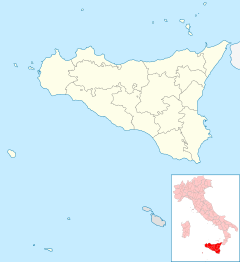Cathedral of Syracuse
| Cattedrale metropolitana della Natività di Maria Santissima | |
|---|---|
Catholic | |
| Region | Sicily |
| Location | |
| Country | Italy |
| Geographic coordinates | 37°03′35″N 15°17′36″E / 37.059617°N 15.293433°E |
| Architecture | |
| Type | Cathedral |
| Style | Sicilian Baroque |
| Part of | Syracuse and the Rocky Necropolis of Pantalica |
| Criteria | Cultural: (ii)(iii)(iv)(vi) |
| Reference | 1200-003 |
| Inscription | 2005 (29th Session) |

The Cathedral of Syracuse (Duomo di Siracusa), formally the Cattedrale metropolitana della Natività di Maria Santissima (Metropolitan Cathedral of the Most Holy Nativity of Mary), is an ancient Catholic church in Syracuse, Sicily, the seat of the Catholic Archdiocese of Siracusa. Its structure is originally a Greek doric temple, and for this reason it is included in a UNESCO World Heritage Site designated in 2005.[1]
The cathedral stands in the city's historic core on Ortygia Island.
History
The origins of a temple on this site date to prehistory. The great Greek
Archeological site excavations by Paolo Orsi in 1907-1910 show the Greek temple to have been built on even older foundations, and uncovered a wealth of archaic and pre-Hellenic artefacts. Many are held by the Museo archeologico regionale Paolo Orsi in Syracuse.
The present cathedral was constructed by Saint Bishop Zosimo of Syracuse in the 7th century. The battered Doric columns of the original temple were incorporated in the walls of the current church. They can be seen inside and out.[3] The building was converted into a mosque in 878, then converted back when Norman Roger I of Sicily retook the city in 1085.[4] The roof of the nave is of Norman origin, as well as the mosaics in the apses.
As part of the increased building activity after the
The interior of the church, a nave and two aisles, combine rustic walls and Baroque details. Features include a font with marble basin dating from the 12th or 13th century, a ciborium (an altar canopy) designed by architect Luigi Vanvitelli, and a statue of the Madonna della Neve ("Madonna of the Snow", 1512) by Antonello Gagini.
St. Lucy
As of 2015 the cathedral holds a number of relics of
The cathedral shares the Piazza Duomo with the Church of Santa Lucia alla Badia, a short walk to the south. That church used to display the Caravaggio painting Burial of St. Lucy, now housed in the church of Santa Lucia al Sepolcro in Syracuse.
World Heritage Site
The cathedral stands as a major element of the historic core of Syracuse. Since 2005, the entire city of Syracuse, along with the
The deciding committee which evaluates potential candidates described their reasons for choosing Syracuse because "monuments and archeological sites situated in Syracuse are the finest example of outstanding architectural creation spanning several cultural aspects; Greek, Roman and Baroque", following on that Ancient Syracuse was "directly linked to events, ideas and literary works of outstanding universal significance".[6]
Gallery
-
ancient columns of the Temple of Athena, incorporated into the cathedral
-
model reconstruction of the temple's Doric facade
-
Watercolor by French travel writer Jean-Pierre Houël circa 1776
-
Facade and flank
-
Interior, pulpit
-
Marabitti, statue of the Virgin
-
Saint Paul on the facade of the Cathedral of Syracuse.
-
Stained glass window of the St Lucia chapel, Cathedral of Syracuse
References
- ^ UNESCO World Heritage Centre. "Syracuse and the Rocky Necropolis of Pantalica". whc.unesco.org. Retrieved 2017-09-08.
- ^ Linder, Douglas. "Second Pleading (fourth oration) of Cicero in Gaius Verres Trial". law2.umkc.edu. Retrieved 2017-09-08.
- ^ The Oxford Companion to Archaeology, by Brian M. Fagan, 1996, page 646
- ^ Salerno, Vincenzo. "Siracusa Cathedral", Best of Sicily Magazine, 2012
- ^ Saints In Rome and Beyond, by Daniel Thelen, pages 129-130
- ^ "Syracuse and the Rocky Necropolis of Pantalica". UNESCO. 8 January 2008.










